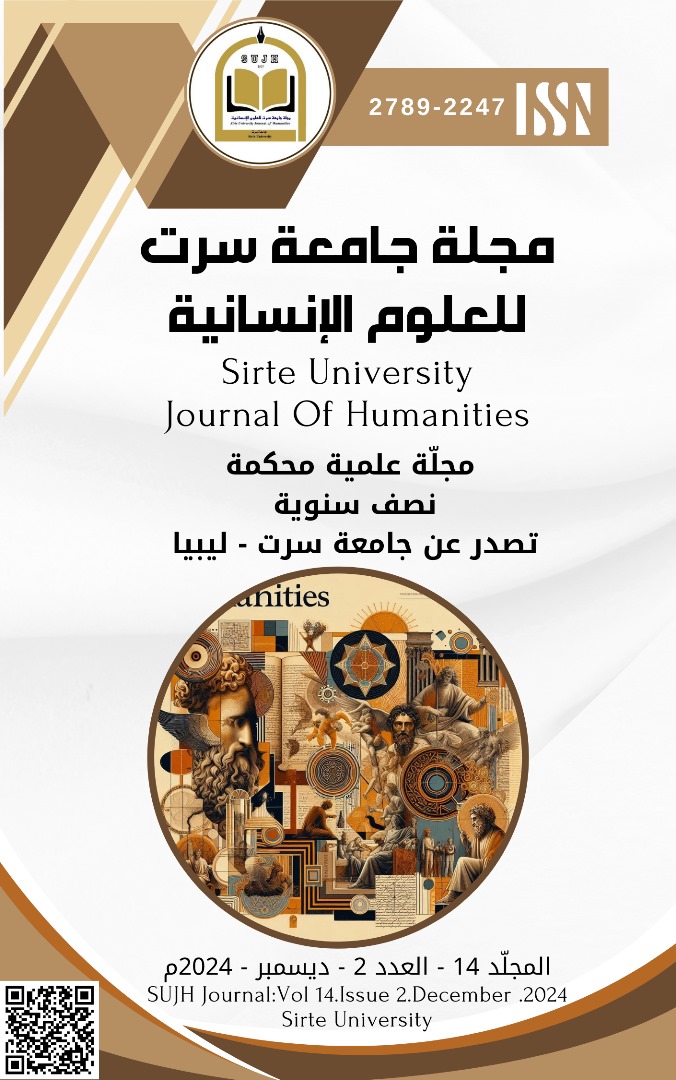العلاقة بين اضطراب جودة النوم والقلق المعمم لدى النازحين في مدينة درنة بعد إعصار دانيال
DOI:
https://doi.org/10.37375/sujh.v14i2.3056الكلمات المفتاحية:
النوم، المعمم، النازحين، إعصار، دانيالالملخص
هدفت هذه الدراسة إلى التعرف على طبيعة العلاقة بين اضطراب جودة النوم، والقلق المعمم لدى النازحين الناجين من الكوارث الطبيعية في مدينة درنة عقب إعصار دانيال. اعتمد الباحثان على المنهج المختلط الذي يجمع بين الأساليب الكمية، والنوعية لتقديم صورة شاملة ودقيقة، واستخدمت الدراسة مقياسي جودة النوم والقلق المعمم كأدوات رئيسية لقياس المتغيرات، وشملت عينة الدراسة (162) نازحًا تأثروا بالإعصار، بالإضافة إلى مقابلات مع (30) نازحًا، و(10) اختصاصيين في مجال علم النفس، وأظهرت النتائج إن مستوى اضطراب جودة النوم كان متوسطًا، بينما مستوى القلق المعمم كان مرتفعاً بين النازحين، كما بينت نتائج الدراسة وجود علاقة ارتباطية موجبة بين اضطراب جودة النوم ومستوى القلق المعمم، كما كشفت المقابلات شبه المنظمة عن معاناة النازحين من الأرق، والانشغال المستمر بالأفكار السلبية، ومن ومن أهم توصيات الخبراء في المجال النفسي أن العلاج السلوكي المعرفي يعتبر وسيلة فعالة لتحسين جودة النوم وتقليل القلق المعمم.
المراجع
أبو غزالة، مروان. (2007). العوامل المعرفية المرتبطة بالقلق المعمم لدى طلبة الجامعة الأردنية. مجلة الدراسات النفسية، 22(1)، 1-24.
بار، أحمد. (2009). السلوك الإنساني: نظريات وتطبيقات. دار المعرفة للنشر والتوزيع.
باسم، أحمد. (2020). أساسيات البحث العلمي: المفاهيم والتطبيقات. القاهرة: دار النشر للعلوم.
الحربي، عبد الله. (2016). "تأثير الكوارث الطبيعية على الصحة النفسية". مجلة الصحة النفسية.1(12) 3ص ص 150-165 .
الحسن، علي. (2021). العلاقة بين التعرض للإساءة في الطفولة وأعراض اضطراب القلق المعمم لدى البالغين. مجلة الدراسات النفسية، 22(1)، 24-33.
الحكيم، سليمان. (2010). العلاقة بين أساليب التفكير والقلق المعمم لدى عينة من المراهقين الفلسطينيين. مجلة جامعة النجاح للبحوث، 24(1)، 15-32.
الخاطر، علاء. (2008). الوراثة وعلاقتها باضطراب القلق المعمم. مجلة العلوم الطبية العراقية، 29(4)، 283-290.
خضر، نور. (2018). العلاقة بين استراتيجيات التكيف مع التوتر وأعراض اضطراب القلق المعمم لدى المرضى النفسيين. مجلة علم النفس الإكلينيكي، 10(1)، 33-44.
الخطيب، عبير. (2019). أنماط التفكير السلبية وتأثيرها على مستوى القلق المعمم لدى طلبة الجامعة. مجلة العلوم الإنسانية، 20(3)، 26-37.
الخطيب، محمد. (2020.( اضطرابات النوم: الأسباب والأعراض والعلاج. دار الفكر العربي، مصر.
الزايد، عمر. (2005). العوامل البيولوجية المرتبطة باضطراب القلق المعمم. مجلة الطب النفسي العربية، 22(3)، 34-42.
الزغبي، عبير. (2019). اضطراب جودة النوم وعلاقته بالقلق المعمم لدى مرضى السكري من النوع الثاني. مجلة جامعة عين شمس للعلوم الطبية، 43(3)، 577-584.
الزهراني، فاطمة. (2018). علم النفس والنوم: النظريات والتطبيقات. دار الفكر العربي، مصر.
زين، نوال. (2006). العلاج النفسي للاضطراب القلق المعمم: مراجعة للأدب. مجلة علم النفس السريري، 17(2)، 123-134.
السعدون، خالد. (2017). دور اضطرابات الغدة الدرقية في ظهور أعراض اضطراب القلق المعمم. مجلة الطب الباطني، 23(4)، 28-35.
السيد، حسام. (2003). العوامل النفسية الديناميكية المرتبطة باضطراب القلق المعمم. مجلة علم النفس، 24(1)، 5-18.
السيد، ندى . (2017). العلاج السلوكي والمعرفي للأرق. دار الفجر للنشر، مصر.
عادل، أحمد. (2018). اضطراب القلق المعمم: فهمه وعلاجه. دار المعرفة للنشر والتوزيع.
عبد الدائم، أنيس محمد. "النمذجة البنائية للقلق المعمم لدى البالغين في مدينة درنة". مجلة الأكاديمية للعلوم الإنسانية. المجلد 23، العدد 25، 2023، الصفحات 88-104.
عبد الرحمن، حسن. (2019). مناهج البحث العلمي: النظريات والتطبيقات. بيروت: دار النشر الحديثة.
عبد الرحمن، سعاد. (2019). التغلب على القلق والتوتر. دار النشر العربية.
عبد الرحمن، عادل. (2019). التوتر والقلق وعلاقتهما بالنوم. مجلة الأبحاث النفسية، 23(2)، 45-68.
عبدالسلام، محمد. (2013). اضطرابات القلق: النظرية والعلاج.
العبدلي، ناصر. )2020 .( الجوانب البيولوجية للنوم. دار النهضة العربية، لبنان.
العبيدي، محمود. (2016). اضطراب القلق المعمم: دراسة مقارنة بين مرضى القلق المعمم ومرضى اضطراب الوسواس القهري. مجلة جامعة الأزهر، 42(1)، 155-175.
عريقات، أحمد. (2011). العوامل الاجتماعية والثقافية المرتبطة بالقلق المعمم لدى عينة من النساء العربيات. مجلة الدراسات الاجتماعية، 34(2)، 203-222.
العصفور، جاسم. (2016). تأثير بعض الأدوية على ظهور أعراض اضطراب القلق المعمم. مجلة الصيدلة السريرية، 9(2)، 35-42.
عمر، محمد. (2022). دور العوامل الوراثية والبيئية في تنبؤ الإصابة باضطراب القلق المعمم لدى مرضى العيادات النفسية. مجلة الطب النفسي، 43(2)، 17-24.
غانم، محمد حسن. (2009) مقدمة في الصحة النفسية (تأصيل نظري ودراسات ميدانية ) دار النهضة للنشر والتوزيع .
القحطاني، عبد الله. (2019). النوم والأرق: الأسباب والعلاج. دار النشر العربية، المملكة العربية السعودية.
القرضاوي، محمد. (2017). الصحة النفسية: النظرية والتطبيق. دار الكتاب العربي.
المانع، فاطمة. (2020). العوامل النفسية والاجتماعية المرتبطة بظهور أعراض اضطراب القلق المعمم لدى المراهقين. مجلة التربية النفسية، 13(2)، 31-40.
المعاني، محمد. (2014). دور الدعم الاجتماعي في الوقاية من اضطراب القلق المعمم. مجلة علم الاجتماع، 57(3)، 187-204.
الموسوي، علي. (2018.( الأرق واضطرابات النوم. دار النهضة العربية، لبنان.
الموسى، أحمد. (2023). العوامل المؤثرة في الإصابة باضطراب القلق المعمم لدى طلاب جامعة الملك عبد العزيز. مجلة العلوم السلوكية، 25(3)، 22-31.
النجار، محمد. (2012). اضطرابات القلق: فهمها وعلاجها. دار عالم المعرفة.
هايز، ستيفن. (2017). أسرار العقل القلق. ترجمة: محمد عفيفي. دار الكتب خان .
• المراجع الاجنبية :
- Adams, J. S., & Colson, M. E. (2016). Behavioral sleep medicine: A comprehensive guide. Springer.
- American Psychiatric Association. (2013). Diagnostic and statistical manual of mental disorders (5th ed.). American Psychiatric Publishing.
-
- Bourne, E. J. (2017). The anxiety and phobia workbook. New Harbinger Publications.
-
- Burns, D. (2018). Feeling good: The new mood therapy. Avery Publishing Group.
-
- Buysse, D. J., Reynolds, C. F., Monk, T. H., Berman, S. R., & Kupfer, D. J. (1989). The Pittsburgh Sleep Quality Index: A new instrument for psychiatric practice and research. Psychiatry Research, 28(2), 193-213.
-
- Charney, D. S., & Drevets, W. C. (2002). The neurobiological basis of anxiety disorders. Biological Psychiatry, 51(7), 935-944.
-
- Cox, R. C., & Olatunji, B. O. (2016). A meta-analysis of the relationship between anxiety sensitivity and sleep disturbances. Sleep Medicine Reviews, 27, 77-88.
-
- Espinola-Caballero, J., Esquivias, G., & Miranda-Montes, H. (2019). Sleep quality and generalized anxiety disorder: A systematic review and meta-analysis. Sleep Medicine Reviews, 48, 100575.
-
- Good, M., & Lai, H. (2005). Sleep disorders in the general population.
-
- Harvey, A. G. (2008). Insomnia, psychiatric disorders, and the transdiagnostic perspective. Current Directions in Psychological Science, 17(5), 299-303.
-
- Hettema, J. M., Neale, M. C., & Kendler, K. S. (2001). A review and meta-analysis of the genetic epidemiology of anxiety disorders. American Journal of Psychiatry, 158(10), 1568-1578.
- Institute of Medicine (US) Committee on Sleep Medicine and Research. (2006). Sleep disorders and sleep deprivation: An unmet public health problem. National Academies Press.
- Johnson, E. O., Roth, T., Breslau, N., & Roehrs, T. (2019). Sleep in America: Epidemiology and public health implications. Cambridge University Press.
- Lai, B. S., La Greca, A. M., Llabre, M. M., & Hadi, F. (2013). Anxiety and sleep disturbances in children and adolescents following a natural disaster: The role of parental monitoring. Journal of Pediatric Psychology, 38(7), 764-774.
- Lopez-Carresi, A., Fordham, M., Wisner, B., Kelman, I., & Gaillard, J. C. (2013). Disaster management: International lessons in risk reduction, response and recovery. Routledge.
- Matsumoto, K., Kimura, M., Hayashi, T., & Ohshima, N. (2013). Sleep disturbances and psychiatric disorders after a natural disaster: Findings from the Great East Japan Earthquake and Tsunami. Sleep Medicine, 14(11), 1150-1155.
- Mellman, T. A., David, D., Bustamante, V., Torres, J., & Fins, A. I. (2001). Psychological factors associated with insomnia in the aftermath of the World Trade Center terrorist attacks: A case series. The Journal of Clinical Psychiatry, 62(10), 923-930.
- Norris, F. H., Friedman, M. J., & Watson, P. J. (2002). 60,000 disaster victims speak: Part I. An empirical review of the empirical literature, 1981–2001. Psychiatry, 65(3), 207-239.
- Norris, F. H., Friedman, M. J., Watson, P. J., Byrne, C. M., Diaz, E., & Kaniasty, K. (2002). Mental health consequences of natural and human-made disasters: Epidemiology, prevalence, and risk factors. Journal of Consulting and Clinical Psychology, 70(3), 490-499.
- Porter, R. J., Bourke, C., & Gallagher, P. (2013). The neurobiology of treatment-resistant depression: Integrating the clinical and preclinical perspectives. Cambridge University Press.
- Smith, J. A., & Jones, M. L. (2018). Sleep disorders and their impact on health. Oxford University Press.
- Spitzer, R. L., Kroenke, K., Williams, J. B., & Löwe, B. (2006). A brief measure for assessing generalized anxiety disorder: The GAD-7. Archives of Internal Medicine, 166(10), 1092-1097.
- Staner, L. (2003). Comorbidity of insomnia and anxiety disorders. Sleep Medicine Reviews, 7(1), 35-46.
- Stein, D. J., & Hollander, E. (Eds.). (2002). Handbook of anxiety disorders. Marcel Dekker.
- van der Kolk, B. (2014). The body keeps the score: Brain, mind, and body in the healing of trauma. Penguin Books.
- van Griensven, F., Chakkraband, M. L., Thienkrua, W., Pengjuntr, W., Lopes Cardozo, B., Tantipiwatanaskul, P., & Mock, P. A. (2006). Prevalence of post-traumatic stress disorder and major depression among adolescent and adult victims of the 2004 tsunami in Indonesia: A systematic review. Journal of Child Psychology and Psychiatry, 47(3-4), 367-374.
- Winkelman, J. W., & Gooneratne, N. S. (2011). Insomnia and sleep-related breathing disorders. Chest, 139(6), 1528-1540.













